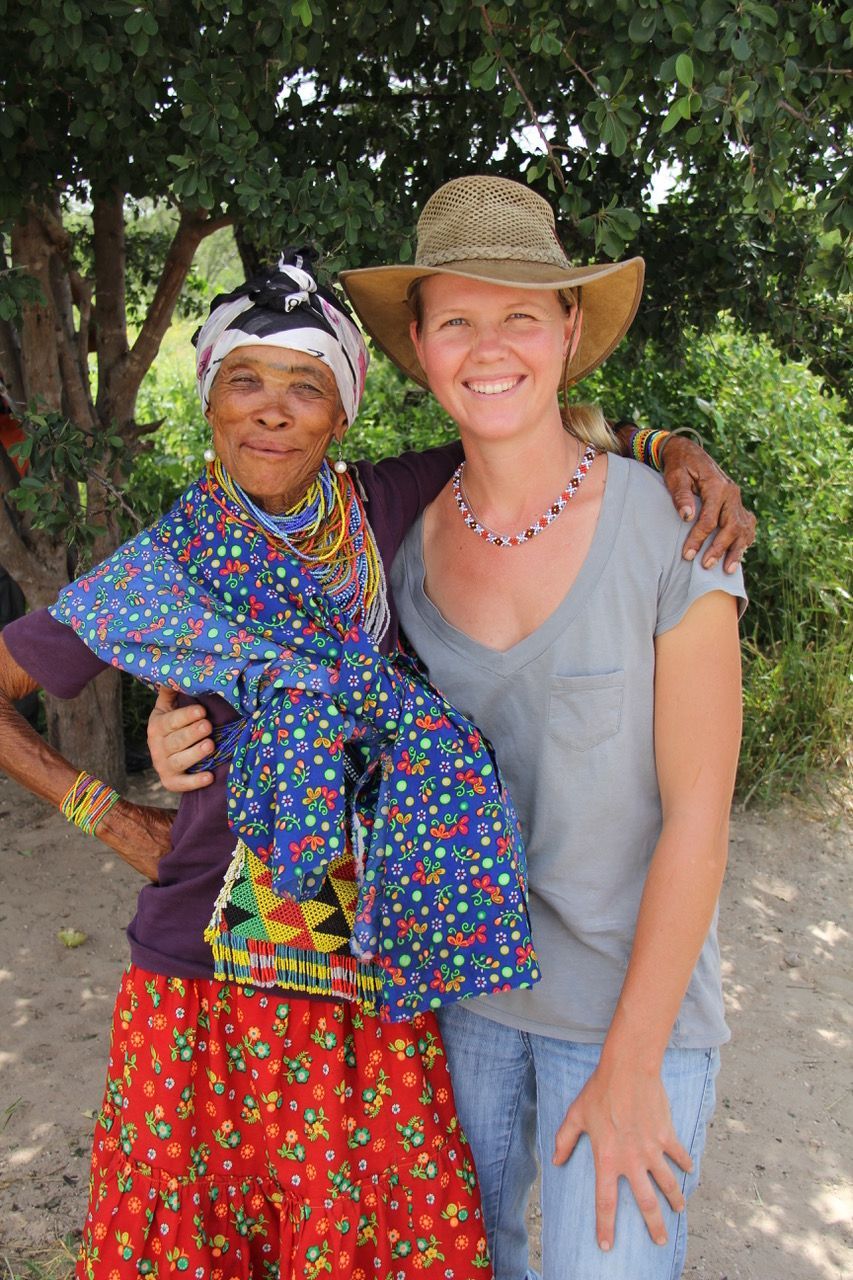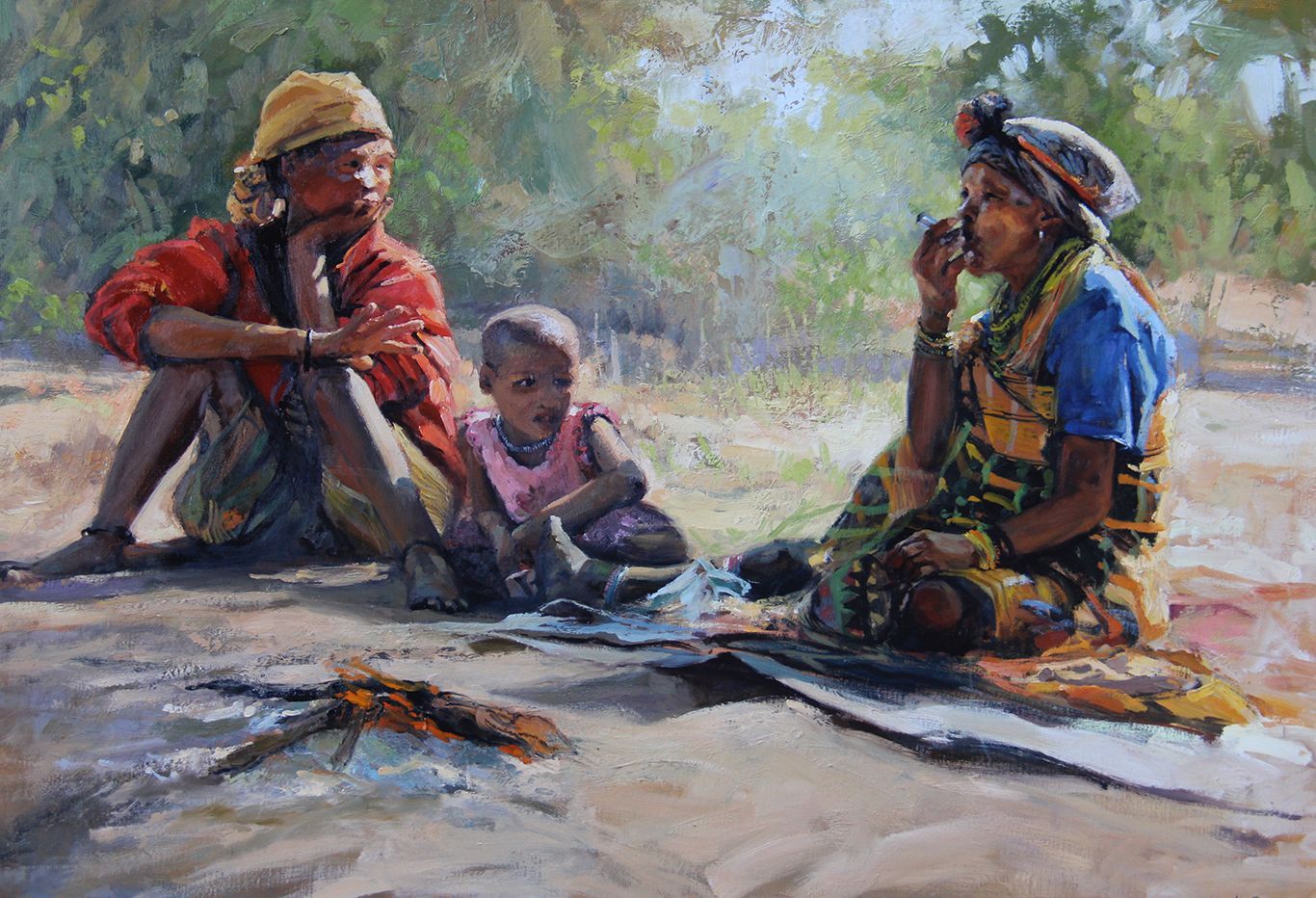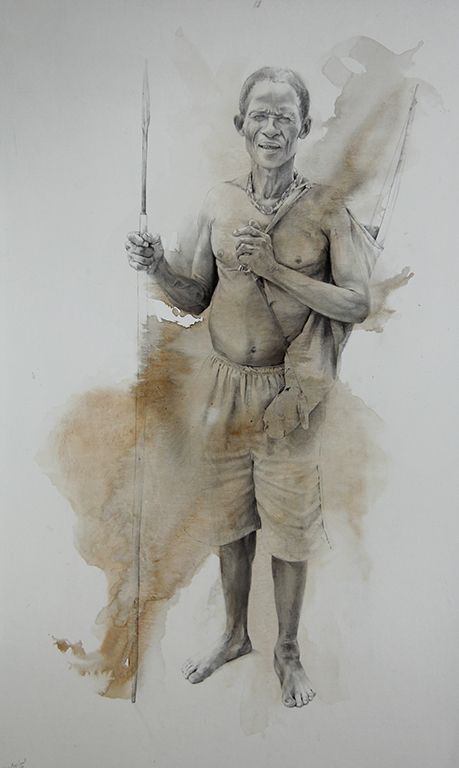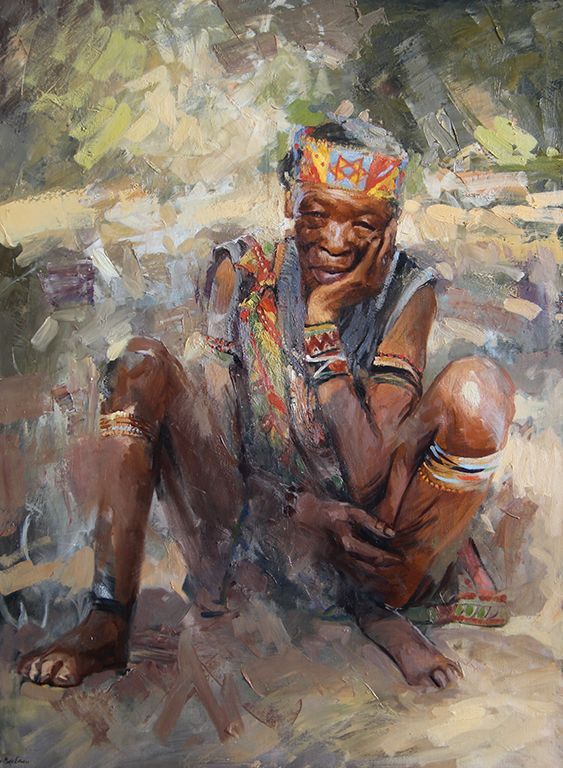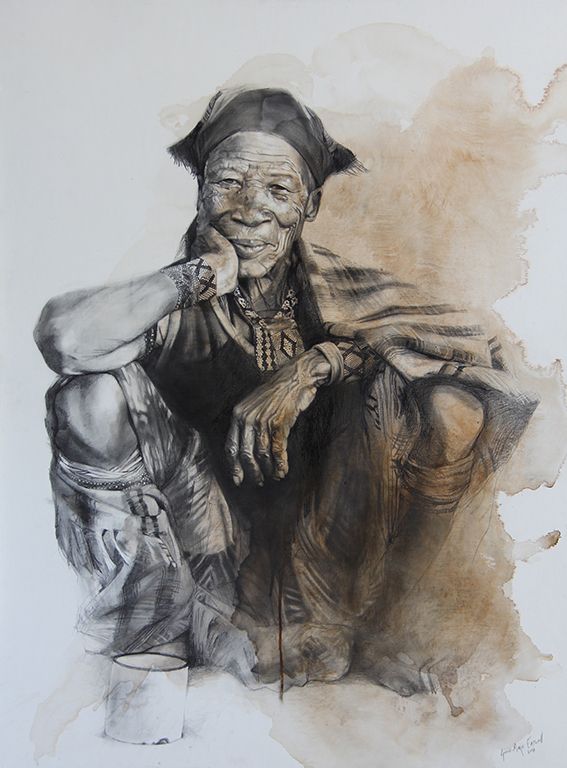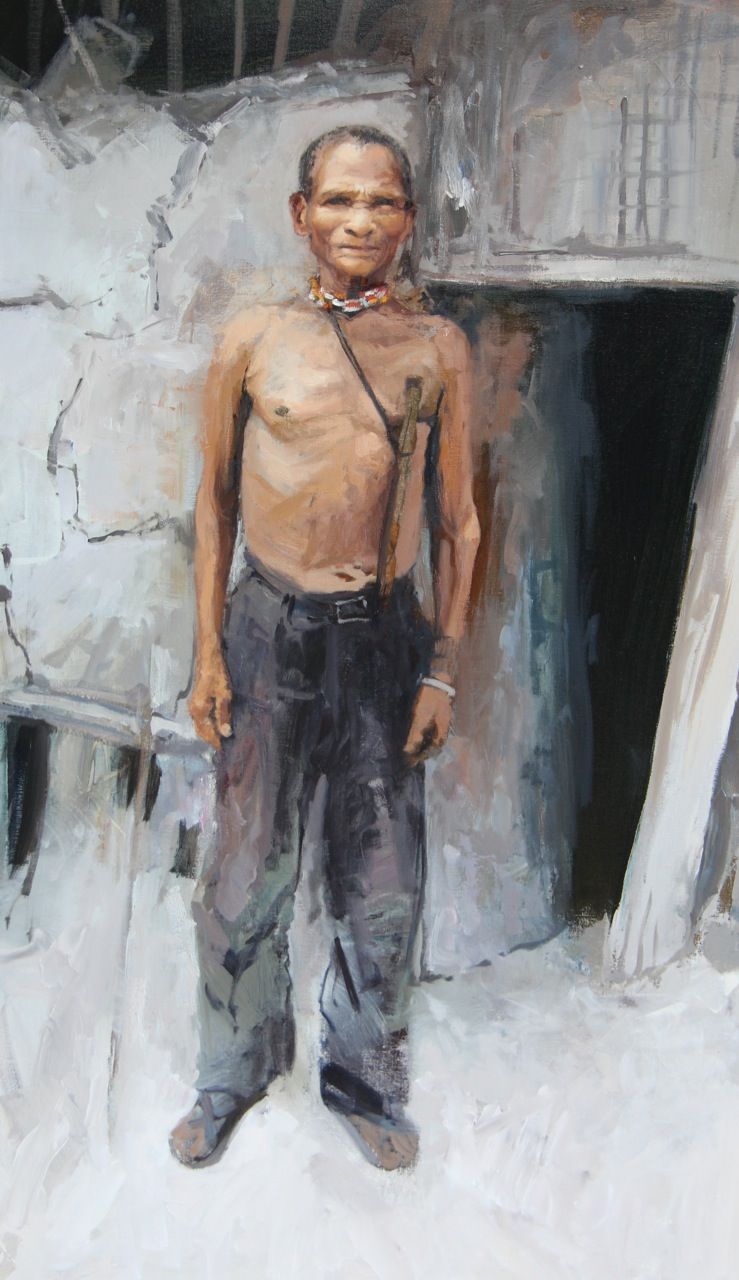The First Journey to Ilauru.
In the Artist's Own Words.
“As a young girl I was inspired by a book on my shelf that once belonged to my grandmother. It was about North-eastern Namibia. I remember looking at pictures of San People, typically portrayed in loincloth with bow and arrow in hand. There was an image of a young Khoisan girl; her features where delicate and I suppose she reminded me a bit of myself, her western t-shirt was stained by the earth while mine washed clean of any blemish. I remember thinking to myself that one day, I would like to find these people and paint their portraits. I would like to travel the world and have an adventurous life and I wanted my art to take me there.
I woke up one morning in my apartment in Santa Monica thinking, “It’s now or never” I either follow that dream or would one day have to make peace with myself for not trying and that I was not prepared to do.
On my return to South Africa, and with the financial support of the Foundation secured, I immediately started researching and contacting people who worked with the Khoisan in South Africa. Through a twist of fate, I was introduced to a person who lived literally a few blocks away from my home in Noordhoek, called David Bruce. David was a photographer who had dedicated the past twenty-five years of his life to photographing the Ju/hoansi Khoisan of Namibia and he was about to leave on a filming trip. That same Sunday evening, on 17 March 2013 I got the call from David to say that he was leaving at 4am Tuesday morning and I could come along if I liked. It was the opportunity of a lifetime.
Tuesday morning came and we left in his 1997 Land Rover Defender almost as complete strangers. It took us four days driving the 2300 km between Noordhoek and the Namibian/Botswana border, at no more than 90 km/h.
"It was my sketchbook that proved to be the best icebreaker."
We finally arrived at the village of Nhoma, about 40km from Tsumkwe, close to the Naye-Naye Concession Area. It was overwhelming seeing the San for the first time, they were even smaller than I had imagined and were dressed in bright clothes, patterned skirts and colourful beads, they had their own definite sense of fashion, striking and shocking to the senses as if they were making up for all the centuries of having no access to colour. The children, of which there were many, had simple hand-me-downs that did not fit their tiny bodies, more closely resembling garage rags than children’s clothing, but everyone seemed happy and as I would soon see, would spend all their waking hours at play.
The Ju/hoansi Khoisan are the only San who still live on ancestral land and the only ones who still practice the tradition of trance dancing. It was this that David had come to film and when morning came, he left in the Land Rover to collect elders from other villages, leaving me on my own to settle in and find my place in the village. I sat with the woman around the fire while they boiled tea in a large black kettle, actually it would end up being sugar with some tea mixed into it, as I would learn the San like sugar and sweet things almost as much as they like to smoke tobacco or “twak” as they call it. Some of the men would speak to me in the Afrikaans language, but the woman generally kept to their own click language.
It was my sketchbook that proved to be the best icebreaker; they passed through the drawings I made in Florence and western buildings with little interest, but would pause for long discussions when it came to the drawings of horse anatomy and nude studies from life drawings.
On the second day I took out my paints and asked the grandma of Nhoma, Ikoece Ghau to sit for a portrait painting.
It took a while to successfully explain what I wanted to do but somehow it all made sense once I confirmed that I would pay for her time. I had to paint sitting down on the ground to get at eye level with my subject, and the desert air was so hot that it made my paint feel as though it would melt from the canvas. The whole village had gathered behind me and the children were practically sitting on my lap. As I sat there with this wise old woman looking back at me, I started to relax. I realized that there was no judgment or expectation other than my own. It was like having many proud grandmothers lovingly give of their time so that I could fulfil my heart’s desire.
During the days I would paint as many portraits as possible, while David worked on preparations for the nights filming, I would help him by recording the sound. As night approached, the elders would prepare for a night of trance dancing in which they would communicate with their ancestors.
It was like nothing I have ever experienced before, standing right in the middle of the dance circle, the woman loudly singing and clapping the
intricate rhythms, while the men went into trance, laying hands on the people in the circle who were in need of healing. The roaring fire was casting warm flickering light on sweat glistening bodies. I could not believe how these people, who during the day looked so frail, barely able to hold up their own frames, would dance right through the night.
During the seven days that we were there I was able to get an intimate glimpse into the everyday life and struggles of today’s Khoisan. I saw the amazing trance dances of the different villages and heard about their concerns for the future, both for their children and their culture. On my return home I started work on a collection of paintings inspired by my trip and in March of 2014 I was fortunate enough to accompany David once again for another three-week trip to Nhoma and the village of IIauru.”
The Second Journey to Nhoma and Ilauru.
In the Artist's Own Words.
“Things were very different for me this time around. I felt more relaxed, having had an idea of what to expect. The only thing I dreaded was not having a shower for a few weeks but even this was thankfully overcome at acceptable intervals. We had three things on the agenda, film more dancing, paint more portraits and renovate a local school for the children. Everything was green and wet, Namibia had been blessed with massive amounts of rain during the rainy season and it wasn’t over yet. The Land Rover had changed colour as we hit the slushy gravel road to Tsumkwe. There were massive pools of water thick with lush grass, everywhere fat donkeys were feasting.
We decided to film the dancing first, hoping that the rain would hold off for just a couple of days. The villagers of Nhoma dance the Elephant Dance; the healers, mostly men, shake their bodies in trance while the woman loudly sing and clap very specific rhythms, each having learned their segment of the song from their mothers before them. As I stood there watching the dance, I realized that I was seeing something very few people on the planet will ever get the chance to see. Time and the concerns of the modern world melted away and for a while it was as though I had been transported hundreds of thousands of years back into history.
After four days of filming, we prepared to move to the village of IIauru but first, we had work to do. David’s charity, ‘The Ju’hoansie development fund’ focuses on education and the building and renovation of schools, some of which have not had any maintenance in over twenty years. One such school near a village on the way was in desperate need of attention. The walls were made of mud from anthills and were partially plastered, snakes and wasps were burrowing in and out of the holes in the walls and the spirit of inspiration had long since left the building.
We set up camp and immediately started to work; sweeping and scraping, mixing plaster, painting walls and window frames - it was exhausting. The nights were eerie, the sounds of hyenas rummaging close by, kept me up for most of the night. Two young men from the nearby village where excited about what we were doing and offered their help, keen to get paint on their clothes to show others how they had contributed to the future of their children. It took four days of hard labor to ultimately get the job done, a marked improvement but albeit a temporary solution to a much greater problem.
It was now time to visit IIauru, a village just off the road to Gum, probably about 100km from Tsumkwe. We had heard about the condition on the road from others who had traveled that way a few weeks before, words like ‘treacherous’ and ‘river’ were used. We took the turnoff to the village, sign posted by a rusted piece of barrel that would go unnoticed by the untrained eye. Driving along the sand track, we started to wonder aloud what everyone was talking about - the words barely left our lips when we turned a corner, and there in front of us lay a stretch of water we could not have imagined. It was difficult to judge how long our journey lasted, or how deep the mud and water really was with all the turns and bends, but we decided to take a chance. I watched as the wheels sank into the mud and then disappear into the ‘river’. A wake was almost over the bonnet as the Landrover pushed its way through the massive body of water. A few yards in we hit a massive bump of who knows what? We kept going at a slow, steady pace trying not to lose momentum and definitely not changing gears. At one point I just couldn’t look out the window anymore and my heart beseeched the help of every angle in the area to carry us through to the other side.
IIauru was different to Nhome in every way possible, the name means “flat rock” and that is what there was. The sand was almost grey and you couldn’t dig a few inches before hitting slabs of whitish-grey rock. The whole village was waiting for us under a tree; they looked thin and grey like the land. I remembered a few people from my first trip - Iam, Thoma and some others - and they recognized me. I got many hugs and was introduced to the rest as the one who draws. We set up camp and I started painting that afternoon, there were many people to paint and many hungry faces keen to earn some money; there was no way I could go home with anything left in my pocket. We had only a limited time available and we thought it best to try to depart before the next rain add to the swollen river that served as the road, the only way out. I painted as many portraits as I could that afternoon and painted the whole of the next day, one by one the elders took their turn to pose, each painting being inspected by the whole village to see if I had captured a good likeness. After three days it was unfortunately time to go, we had pushed our luck far enough.
We had agreed to take Iam, Toma and one other to Gum to do some shopping for food, they had money to spend and tea and tobacco were high on the list, but first we had to get through that river. This time I didn’t even bother to look, I shut my eyes and started praying and when we got to the other side both Iam and I sent up our thanks - what a relief!
Gum was fascinating, I think it was the first time many of the people there had ever seen a blond woman. The Donkeys were waiting at the village turnoff to carry the shopping home and it was time for us to make our journey home. It was sad to say goodbye but I knew that I would be back.
The rain came down on the road out of Tsumkwe as a blessing for the Khoisan, but for me it was Cape Town that lay beyond the horizon.
Exhibitions and Events.
- 2004 June - Group Show at “The Redleaf Gallery”, Turnbridge Wells, Kent, U.K
- 2007 April - Solo Show at “The Orient Hotel” Francolin Conservancy for the Foundation.
- 2009 June - Open Studio Exhibition at “Santa Monica Fine Art Studios”, California.
- 2010 July - Group Show at “Rebecca Molayem Gallery” West Hollywood
- 2010 – 2011 - Studied “Intensive Drawing Program” at The Florence Academy of Art
- 2011 October - Siem Reap, Cambodia. Collection commissioned by the Foundation
- 2013 March - Tsumkwe, Namibia to stay with Khoisan Communities commissioned by the Foundation.
- 2013 May - Opening Exhibition of The Eatwell Gallery, Noordhoek, Western Cape.
- 2013 September - Exhibiting Member of the First Venice Artblock Studio tour, Venice Beach, CA, U.S.A.
- 2014 February - Group Show “Pastoral Symphony” at Rebecca Molayem Gallery, Beverly Hills, CA, U.S.A
- 2014 March - 2nd Journey to Tsumkwe, Namibia to stay with the Khoisan commissioned by the Foundation.
- 2014 August – Solo Exhibition: “Hunter Gatherer, Faces of the Khoisan” at the Orient Boutique Hotel, Pretoria.
- 2018 October - Journey to Mongolia to stay with the Eagle Hunters commissioned by the Foundation.
- 2018 November - Journey to Pushkar to paint the camel fair, commissioned by the Foundation.
